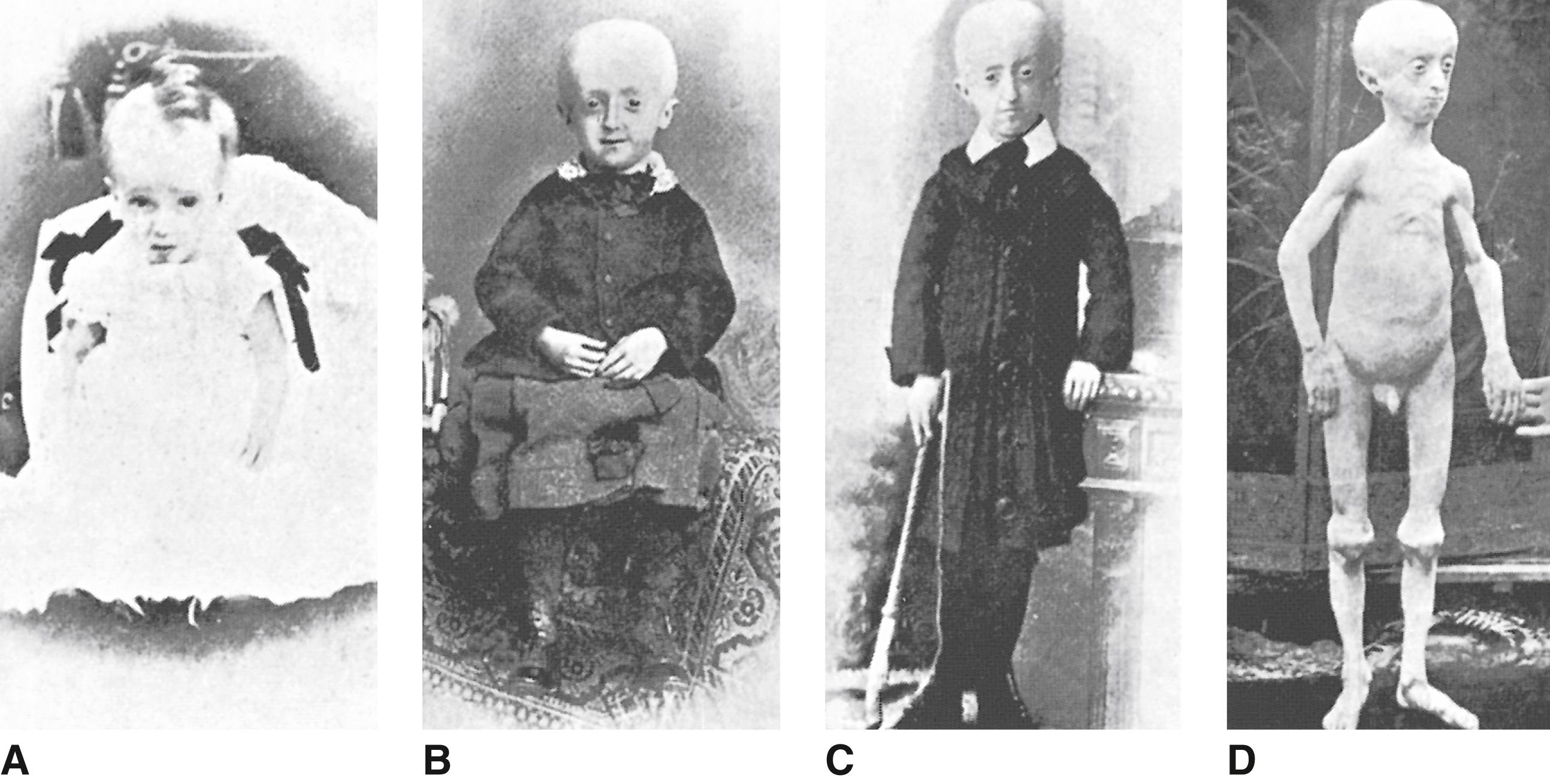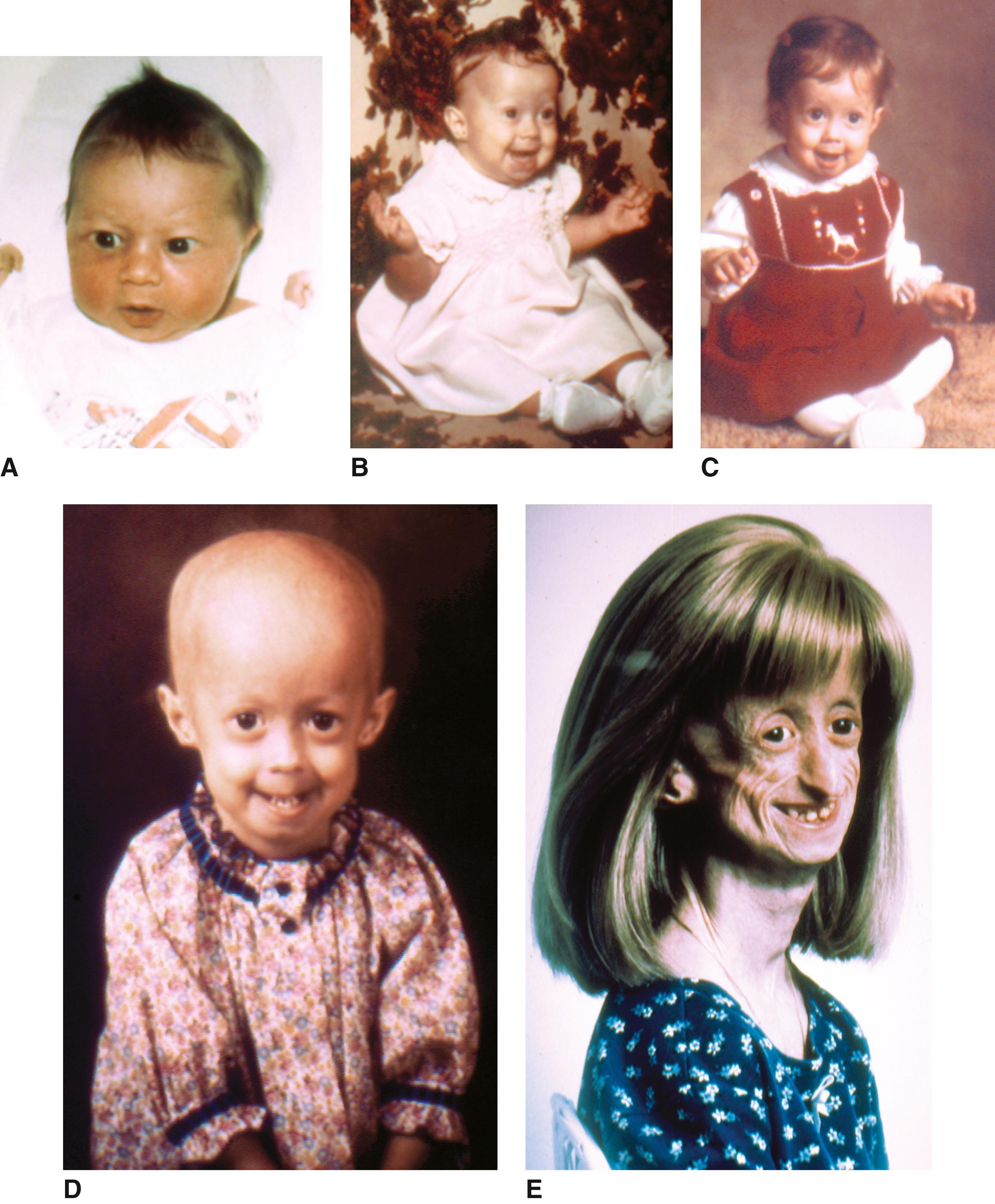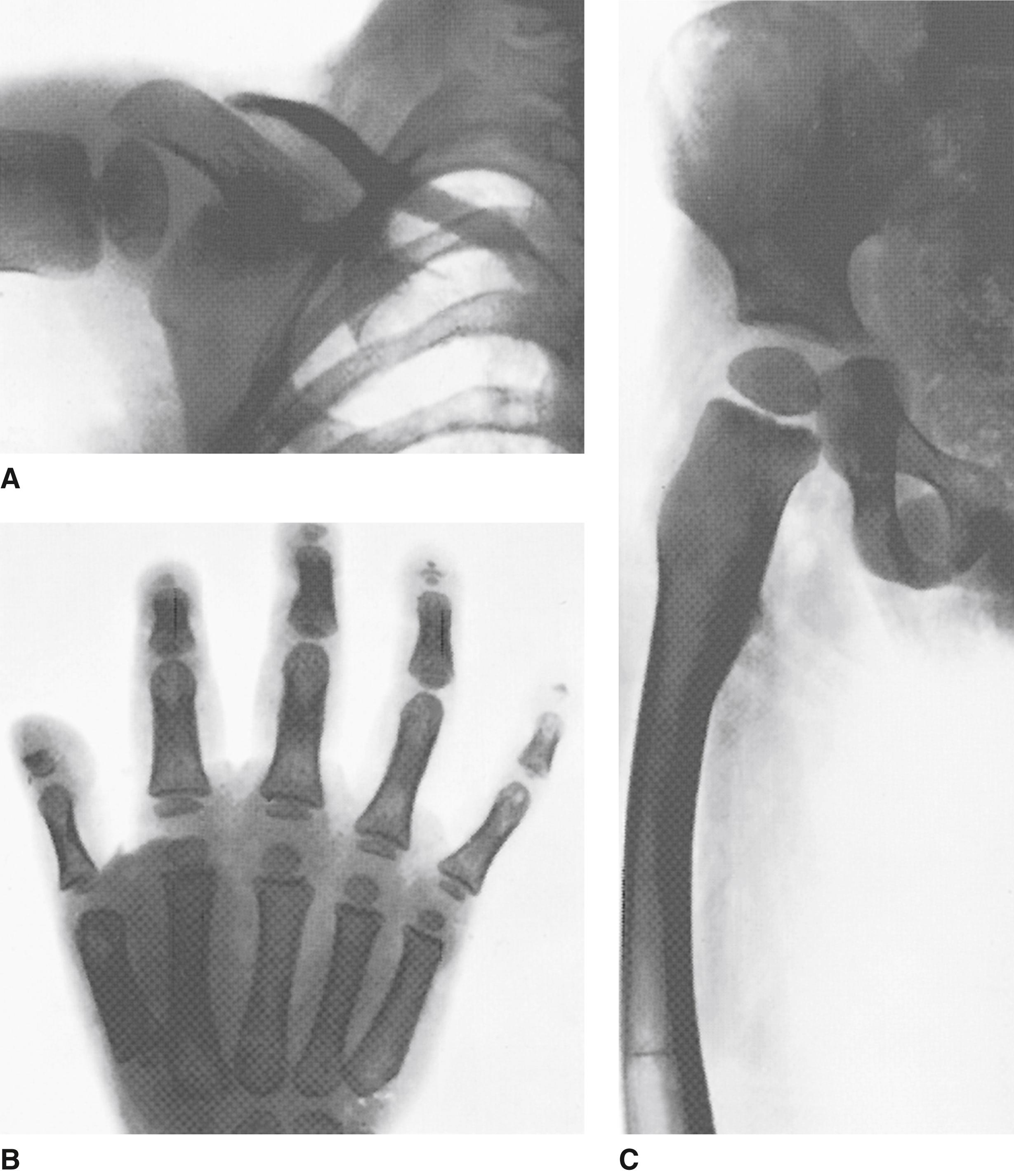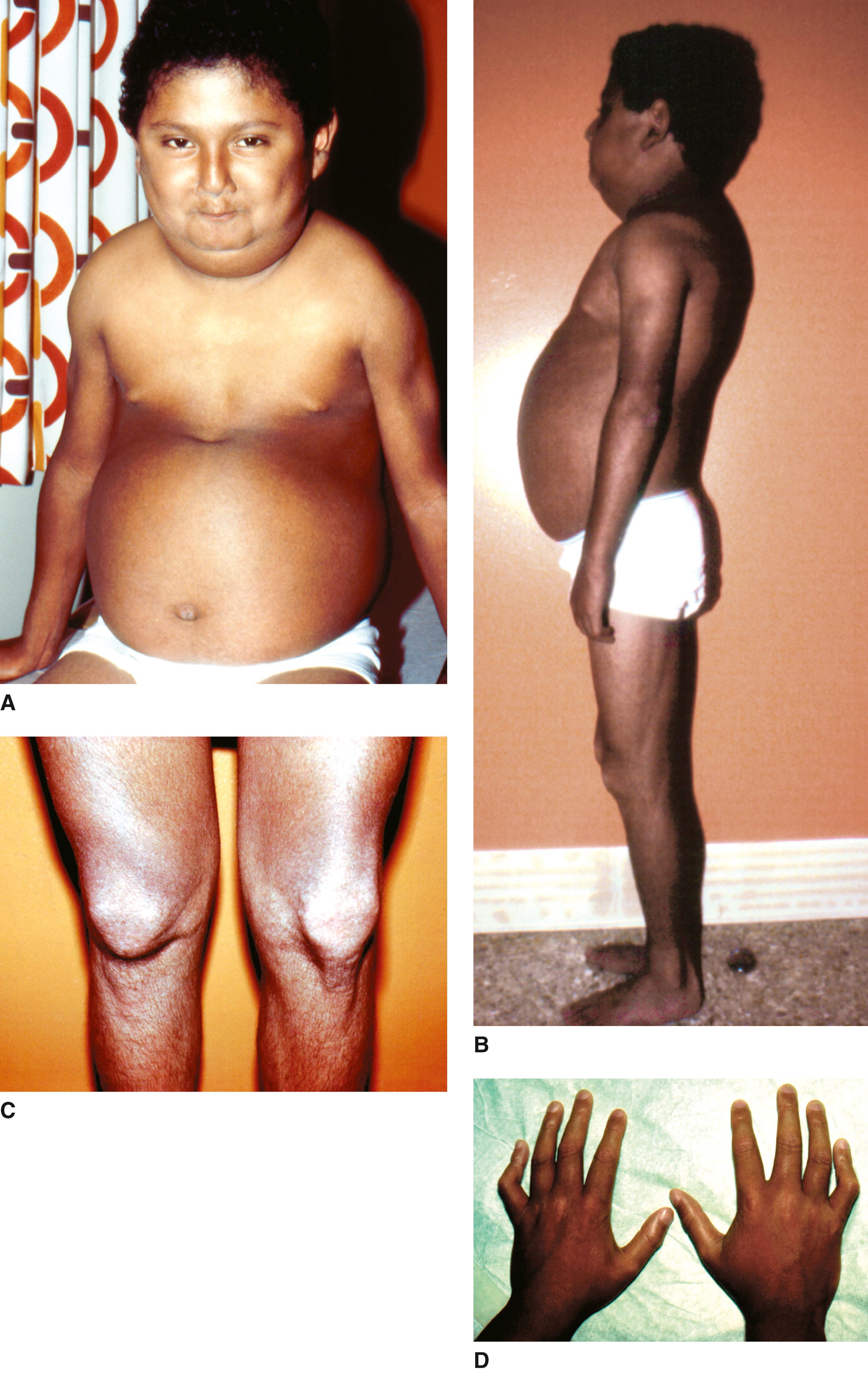Physical Address
304 North Cardinal St.
Dorchester Center, MA 02124
The following entry was recorded in the St. James Gazette in 1754: “March 19, 1754 died in Glamorganshire of mere old age and a gradual decay of nature at seventeen years and two months, Hopkins Hopkins, the little Welshman, lately shown in London. He never weighed more than 17 pounds but for three years past no more than twelve.” In 1886, Hutchinson described a similar patient. Later, Gilford studied this boy and another patient and termed the condition “progeria,” meaning premature aging. DeBusk summarized the findings in 60 cases. Fewer than 50 cases are currently known worldwide.
Growth. Normal birth size; postnatal growth deficiency becomes evident between 6 and 18 months with subsequent growth rate one-third to one-half of normal; diminished subcutaneous fat beginning in infancy, last areas of adipose atrophy are cheeks and pubic areas; postnatal microcephaly.
Performance. Normal intelligence, hyperopia, conductive and/or sensorineural hearing loss.
Craniofacial. Normal appearance at birth, later craniofacial disproportion owing to facial hypoplasia; prominent eyes; thin, long beaked nose; narrow vermillion of upper lip, micrognathia; stiff auricular cartilage; small or absent ear lobule; short external auditory canal; delayed eruption of deciduous and permanent dentition; crowding of teeth; ogival palatal arch; anodontia and hypodontia, especially of permanent teeth; discoloration; high incidence of cavities; ankyloglossia owing to short, thick lingual frenulum; circumoral cyanosis.
Skin. Thinning with onset in early to mid-infancy; prominent scalp veins; localized scleroderma-like areas over lower abdomen, upper legs, and buttocks appearing at birth or early infancy; loss of elasticity; skin dimpling; irregular pigmentary changes over sun-exposed areas that become more prominent with age; skin with irregular dimpling over lower abdomen and/or proximal thighs.
Hair. Alopecia developing in infancy with degeneration of hair follicles; sparse to absent eyelashes and eyebrows.
Nails. Hypoplastic with onset in infancy; nails may be brittle, curved, yellowish.
Limbs. Periarticular fibrosis beginning at 1 to 2 years; progressively stiff or partially flexed prominent joints or both; leads to “horse-riding” stance.
Imaging. Thin calvarium with marked delay in ossification of fontanels; Wormian bones; narrow chest apices; small clavicles; thin ribs; rib fractures; coxa valga; acetabular dysplasia; avascular necrosis of proximal femur, sclerotic changes in the long bones with thinned shafts and pathologic fractures, particularly of the humerus; progressive loss of bone in clavicle and distal phalanges; delayed bone age; dystrophic calcification. Radiographic findings that become more apparent over time, include thinning of ribs, resorption of anterior ribs, generalized osteopenia, ulnar minus variant, sagittal suture diastasis, clavicular resorption or pseudarthrosis, coxa valga, and enlarged femoral greater trochanter. Cephalometric findings include obtuse angle and steep mandibular plane angle.
Congenital or acquired cataract, microphthalmia, absent breast and nipple, scoliosis, Madelung deformity, bifid rib, ivory epiphyses, dislocated hips, immunologic abnormalities, relatively large thymus, lymphoid and reticular hyperplasia, prolonged prothrombin times, elevated platelet counts, insulin resistance. High pitched voice.
In contrast to neonatal progeroid syndromes, the recognition of disease manifestations takes place between birth and 2 years. The average birthweight for 17 patients was 2.7 kg. There may be severe failure to thrive in the first and second year. The deficit of growth becomes more severe and affects stature after 1 year of age. Sexual maturation is severely delayed or even absent. The coxa valga causes a wide-based shuffling gait.
The life span is shortened by the early advent of relentless atherosclerosis associated with hypertension, vascular disease, cardiac valve thickening, transient ischemic attacks, and stroke, without any of the risk factors that commonly cause cardiovascular disease. A key characteristic of Hutchinson-Gilford progeria syndrome (HGPS) is a severe loss of vascular smooth muscle cells in the arteries, which leads to increased deposition of medial collagen and a secondary alteration in elastin structure, and subsequent vascular stiffness. Treatment with dietary nitrites prevents vascular stiffness in progeroid mice. The usual cause of death is a cardiovascular event. The average life expectancy is 13 years. Noninvasive measures of vascular dysfunction (carotid-femoral pulse wave velocity and ankle-brachial index) show changes in children as young as 3 years. The tendency to fatigue easily limits participation in childhood activities. Progressive contractures may eventually restrict activities of daily living. Renal ischemia resulting in focal subcortical scars, diffuse glomerulosclerosis, tubular atrophy, and chronic interstitial nephritis occurs in patients surviving into adolescence. Because intelligence and brain development do not appear to be impaired, children with progeria should be allowed as normal a social life as possible. Low-dose aspirin had been recommended to mitigate vascular events.
Almost always sporadic. Instances of affected siblings from normal parents are probably the result of gonadal mosaicism with autosomal dominant (AD) transmission. The classic progeria mutation present in 90% of cases is a heterozygous c.1824C>T base substitution in LMNA , a silent mutation that results in increased usage of a cryptic splice site that deletes 50 amino acids from the lamin A protein, resulting in production and accumulation of progerin, a defective form of lamin A, a constituent of the nuclear membrane. The amino acid deletion renders progerin permanently intercalated into the inner nuclear membrane where it accumulates and exerts progressively more damage to cells as they age. Individuals with nonclassic genotype HGPS have the characteristic clinical features of HGPS and are heterozygous for other LMNA variants in exon 11 or intron 11 (∼10% of individuals with HGPS). In both the classic and nonclassic types, mutations result in production of a shortened abnormal prelamin A protein or progerin. Therapies aimed at altering the posttranslational processing of lamin A are under investigation and found promising in reducing/delaying mortality. CRISPR-Cas9-based gene therapies revert several alterations in progeria cells in mice by introducing frameshift mutations in the LMNA gene.
The other mutations in LMNA have accounted for atypical progeria with either earlier or later ages of onset. There is some clinical overlap with other conditions including mandibuloacral dysplasia with type B lipodystrophy caused by pathogenic variants in ZMPSTE24 .



Described initially by Cavallazzi and colleagues as an atypical form of cleidocranial dysostosis, mandibuloacral dysplasia (MAD) is a prematurely aging condition. Onset of the phenotype commonly occurs between 3 and 14 years and is slowly progressive, but it can occur earlier and evolve faster, depending on the causal gene involved.
Growth. Postnatal onset of growth deficiency.
Craniofacial. Prominent scalp veins, thin beak-like nose with alar hypoplasia, hypoplastic facial bones with prominent eyes, mandibular hypoplasia, difficulty opening mouth.
Limbs. Short, contracted fingers with short bulbous distal phalanges of fingers and toes, with acroosteolysis, and broad interphalangeal joints; dystrophic nails; generalized joint limitations.
Skin, Hair, Teeth. Thin, mottled, hyperpigmented skin mostly in groin and axillae; progressive thinning and atrophy of skin; prominently visible superficial vasculature; premature loss of teeth; dental crowding and malocclusion; sparse, thin hair.
Imaging. Wormian bones, widened cranial sutures, clavicular hypoplasia, acroosteolysis, hypoplastic distal phalanges, bell-shaped chest. Generalized osteoporosis.
Adipose tissue. Type A pattern lipodystrophy with marked loss of subcutaneous fat from the extremities and milder in the face, with normal or slight excess in the neck and truncal regions. Type B pattern generalized lipodystrophy involves the face more severely, as well as the trunk and extremities.
Other. Osteolysis of medial end of clavicles, metabolic syndrome, insulin resistance, glucose intolerance, diabetes mellitus, hypertriglyceridemia, acanthosis nigricans.
Neonatal tooth eruption, amorphous calcific deposits, submetaphyseal erosions, vertebral beaking, scoliosis, and delayed healing of fracture. Cataracts, hypospadias, delayed puberty, hypogonadism, hepatomegaly, renal failure secondary to focal mesangial scleroses, congenital myopathy.
Affected children are normal at birth. Characteristic features of ocular proptosis, micrognathia, loss of facial fat, and short bulbous distal phalanges usually develop between 3 and 14 years and can lead to early suspicion of the disorder. Later, growth deficiency and progressive skeletal changes, involving primarily the clavicles, and digits with acro-osteolysis of the medial end of the clavicles and the distal phalanges (occurring earliest in the second digit). Loss of subcutaneous fat leading to a prematurely aging appearance occurs. Most health complications arise from insulin resistance and diabetes mellitus, as well as glomerulopathy.
Mandibuloacral dysplasia has an autosomal recessive inheritance pattern. A mutation in the lamin A/C gene ( LMNA ), which maps to chromosome 1q21, was initially identified in all individuals affected with this disorder. The most common defect is a homozygous missense mutation (p.R527H) in the C-terminal domain of lamin A/C, but different homozygous or compound heterozygous cases have been reported. The LMNA gene is responsible for MAD-A in those families with partial lipodystrophy (type A), but a second gene, ZMPSTE24, is responsible for cases of MAD-B with earlier onset (before 1 year of age). Those children have a more rapidly progressive course, with a generalized pattern of lipodystrophy (type B), severe glomerulopathy, more extensive skeletal changes, and subcutaneous calcifications. ZMPSTE24 encodes a zinc metalloproteinase involved in posttranslational proteolytic cleavage of carboxy terminal residues of farnesylated prelamin A to form mature lamin A. Retention of unprocessed farnesylated prelamin A in the nucleus is toxic to cells. Prelamin A accumulation in MAD affects adipogenesis, bone differentiation, and cellular response to stress.
A broad range of disorders are caused by mutations in the LMNA or the ZMPSTE24 gene, including Hutchinson-Gilford syndrome (progeria), which is caused by LMNA mutations and restrictive dermopathy, which is lethal early in life and occurs with null mutations in ZMPSTE24, leading to absent residual function of the enzyme. At least some residual enzyme activity is usually present in MAD, which explains the milder phenotype. Mandibular hypoplasia, deafness, and generalized lipodystrophy (MDPL) caused by de novo heterozygous mutations in POLD1 is a condition with similar clinical course to MAD and sometimes has been called a MAD variant. There are many distinct features of MDPL such as progressive general lipodystrophy, no acroosteolysis or clavicular hypoplasia, male hypogonadism, early sensorineural hearing loss, no alopecia, and better long-term survival.

Become a Clinical Tree membership for Full access and enjoy Unlimited articles
If you are a member. Log in here